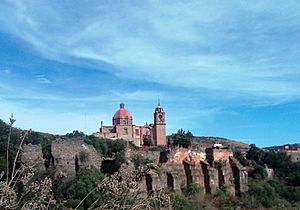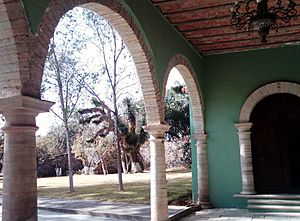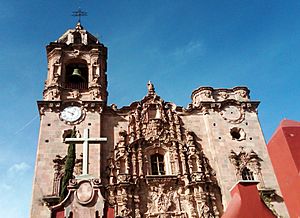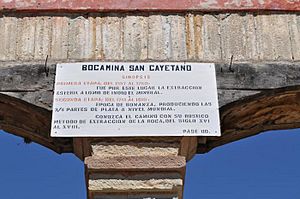Valenciana Mine facts for kids
The Valenciana Mine, or Mina de La Valenciana in Spanish, is a famous silver mine in Guanajuato, Mexico. It's about 6 kilometers from the historic center of Guanajuato City. This mine, along with the city and other nearby mines, is so important that it's a UNESCO World Heritage Site.
Mining for silver started here in the 1500s. The Valenciana Mine produced so much silver that it made up two-thirds of all the silver found in New Spain (which was what Mexico was called back then). Today, the mine is owned by the Santa Fe Cooperative Society of Metallurgical Mines of Guanajuato. They still mine silver here, going as deep as 760 meters underground!
Contents
History of the Valenciana Mine
Even though silver was found in Guanajuato in 1548, the Valenciana Mine became super productive much later. Its best years were from 1768 to 1804. During the 1700s, this mine produced 60% of the world's silver!
How the Mine Became Famous
In 1760, a young man named Antonio de Obregón y Alcocer got a loan to invest in the mine. He and his partner, Pedro Luciano Otero, kept putting money into it. By 1768, the mine's silver production grew a lot. For many decades, La Valenciana Mine produced more silver than all the mines in the Viceroyalty of Peru (another large Spanish territory).
On March 20, 1780, the King of Spain, Charles III of Spain, gave Antonio de Obregón special titles. He became the Viscount de la Mina and the Count of La Valenciana because of the mine's success.
Changes in Ownership and Production
In 1788, Antonio's son, Antonio Alonso de Obregón, took over. The mine's ownership was split into 24 parts. The Obregón family kept ten parts, the Otero family had twelve, and another family, the Santa Anas, had two.
A famous explorer, Alexander von Humboldt, visited the mine on August 8, 1803. He wrote that the mine had made its owners a huge amount of money each year. During its busiest times, over three thousand people worked at the mine. By 1803, they were mining at a depth of 185 meters.
The Mine During Conflicts
In 1810, the Mexican War of Independence began. Many miners from La Valenciana joined the fight. They helped capture a building called the Grain Exchange at Granaditas. Later, they formed a special army group called the Valencia regiment.
In 1817, a leader named Xavier Mina tried to take over Guanajuato. When he couldn't, he ordered the mine's machinery to be burned. This caused a lot of damage. By 1815, the mine had reached a depth of 514 meters, but its production stopped in 1810 because of the war.
Rebuilding and New Challenges
From 1848 to 1865, Francisca Pérez de Gálvez managed the mine. By the end of this time, the company didn't have enough money, and many of its mines were flooded. In 1865, her nephew, Miguel Rul, took over. He worked hard to fix things. He sold his farms to get money for the mines.
Miguel Rul started new companies to work the mines again. By 1878, La Valenciana was once again producing the most silver in Guanajuato. In 1887, it produced 15,000 tons of silver! However, production started to drop after that. By 1889, only 2,400 tons were extracted.
In the 1890s, the mine faced big problems. Not only was less silver being found, but the price of silver also dropped by 40%. When Miguel Rul passed away in 1897, his wife and brother-in-law took over. In 1904, they sold the company to an American company called Guanajuato Reduction and Mines Company.
Modern Era and Worker Ownership
During the Mexican Revolution, most mining stopped. After 1922, American companies invested again, and mining restarted. But then, the Crisis of 1929 (a big economic downturn) caused mining production in Mexico to decrease.
In 1936, the miners at La Valenciana went on strike, which lasted until 1937. Because of these worker issues and lower production, the mine eventually went to the workers themselves. They formed a group called the Cooperativa Minera Metalúrgica Santa Fe de Guanajuato. This cooperative still owns and operates the mine today.
San Cayetano Temple of the Confessor
In the town that grew up around the mine, a beautiful church was built. It's called the church dedicated to San Cayetano. Antonio de Obregón y Alcocer, the mine owner, had it built to thank God for his good fortune.
Construction started in 1775 and finished in 1788. The church was designed by Andrés de la Riva and Jorge Archundia. It's made from pink stone and has a very fancy style called churrigueresque.
The La Valenciana Mine Museum
The mine spreads out underground, beneath the area northeast of Guanajuato City. The main entrance to the mine is called the Bocamina. It's located right behind the San Cayetano church in the town of Valenciana.
Local guides can take visitors on tours of the old mining buildings. You can even go down into the mine using a long, steep staircase! The Mexican government has also created a modern, interactive museum at the site. It's a great way to learn about the mine's history and how silver was extracted.
See also
 In Spanish: Mina de la Valenciana para niños
In Spanish: Mina de la Valenciana para niños





